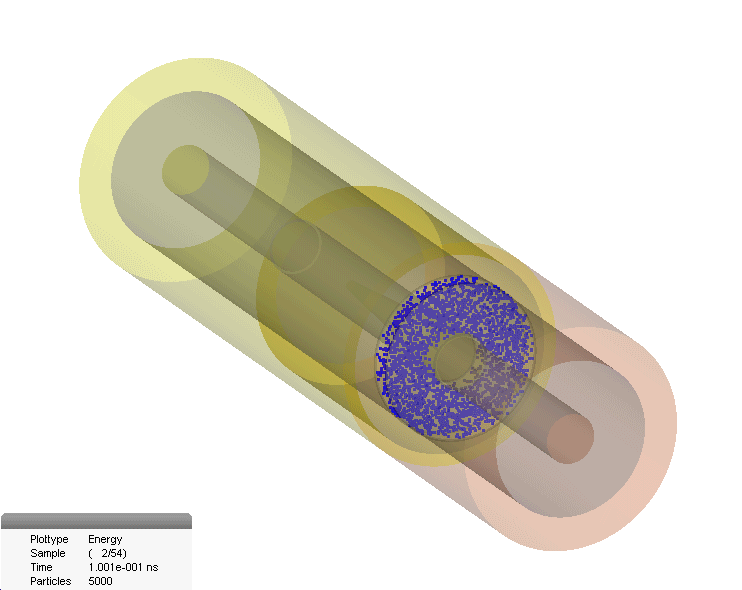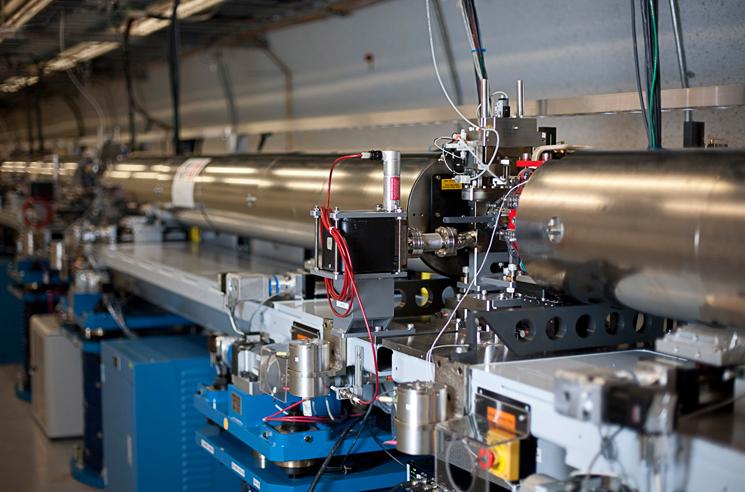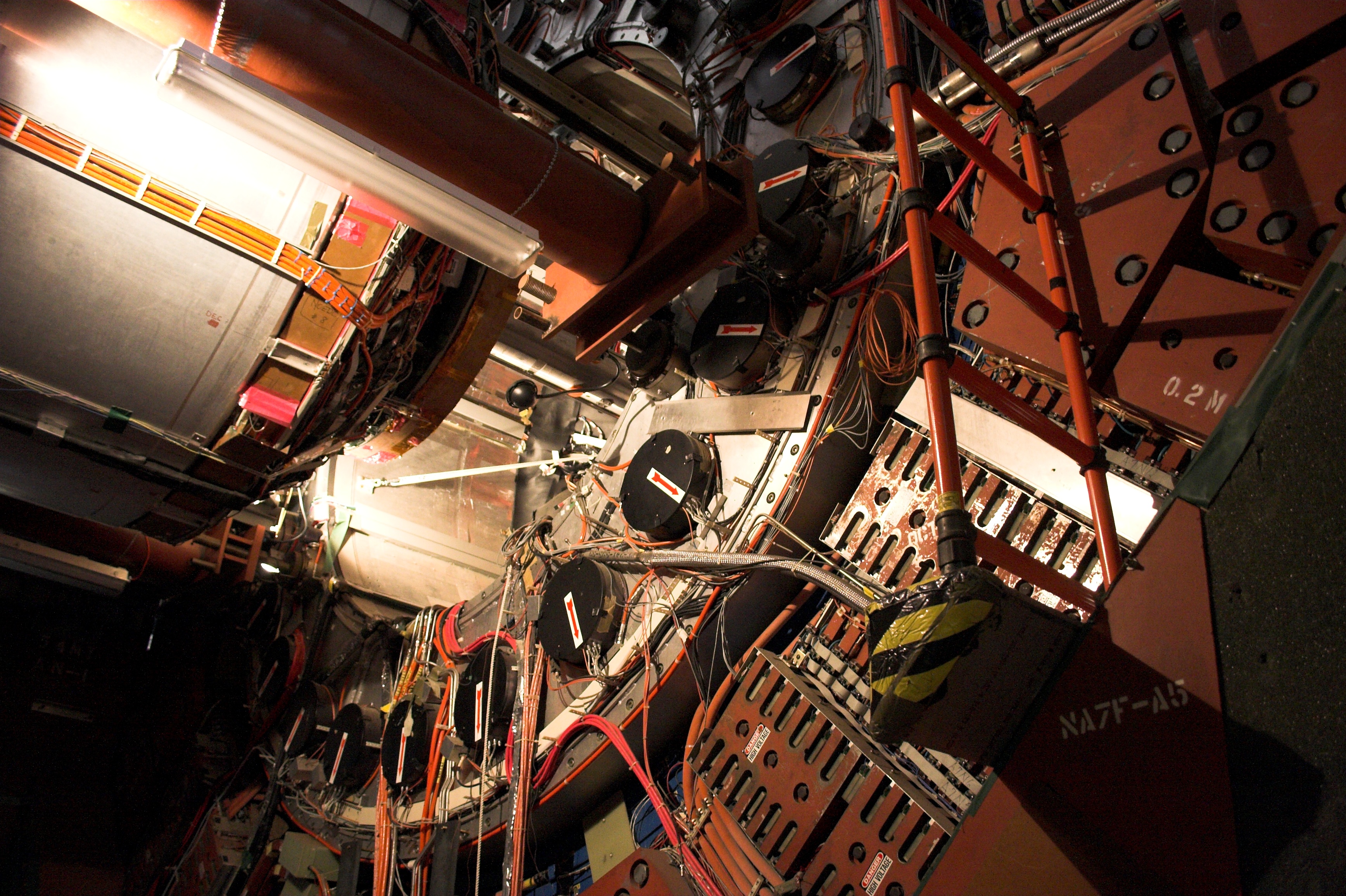|
Electron-cloud Effect
The electron-cloud effect is a phenomenon that occurs in particle accelerators and reduces the quality of the particle beam. Explanation Electron clouds are created when accelerated charged particles disturb stray electrons already floating in the tube, and bounce or slingshot the electrons into the wall. These stray electrons can be photo-electrons from synchrotron radiation or electrons from ionized gas molecules. When an electron hits the wall, the wall emits more electrons due to secondary emission. These electrons in turn hit another wall, releasing more and more electrons into the accelerator chamber. Exacerbating factors This effect is especially a problem in positron accelerations, where electrons are attracted and slingshot into the walls at variable incident angles. Negatively charged electrons liberated from the accelerator walls are attracted to the positively charged beam, and form a "cloud" around it. The effect is most pronounced for electrons with around ... [...More Info...] [...Related Items...] OR: [Wikipedia] [Google] [Baidu] |
Particle Accelerators
A particle accelerator is a machine that uses electromagnetic fields to propel charged particles to very high speeds and energies, and to contain them in well-defined beams. Large accelerators are used for fundamental research in particle physics. The largest accelerator currently active is the Large Hadron Collider (LHC) near Geneva, Switzerland, operated by the CERN. It is a collider accelerator, which can accelerate two beams of protons to an energy of 6.5 TeV and cause them to collide head-on, creating center-of-mass energies of 13 TeV. Other powerful accelerators are, RHIC at Brookhaven National Laboratory in New York and, formerly, the Tevatron at Fermilab, Batavia, Illinois. Accelerators are also used as synchrotron light sources for the study of condensed matter physics. Smaller particle accelerators are used in a wide variety of applications, including particle therapy for oncological purposes, radioisotope production for medical diagnostics, ion imp ... [...More Info...] [...Related Items...] OR: [Wikipedia] [Google] [Baidu] |
Particle Beam
A particle beam is a stream of charged or neutral particles. In particle accelerators, these particles can move with a velocity close to the speed of light. There is a difference between the creation and control of charged particle beams and neutral particle beams, as only the first type can be manipulated to a sufficient extent by devices based on electromagnetism. The manipulation and diagnostics of charged particle beams at high kinetic energies using particle accelerators are main topics of accelerator physics. Sources Charged particles such as electrons, positrons, and protons may be separated from their common surrounding. This can be accomplished by e.g. thermionic emission or arc discharge. The following devices are commonly used as sources for particle beams: * Ion source * Cathode ray tube, or more specifically in one of its parts called electron gun. This is also part of traditional television and computer screens. * Photocathodes may also be built in as a part of an ... [...More Info...] [...Related Items...] OR: [Wikipedia] [Google] [Baidu] |
Charged Particle
In physics, a charged particle is a particle with an electric charge. It may be an ion, such as a molecule or atom with a surplus or deficit of electrons relative to protons. It can also be an electron or a proton, or another elementary particle, which are all believed to have the same charge (except antimatter). Another charged particle may be an atomic nucleus devoid of electrons, such as an alpha particle. A plasma is a collection of charged particles, atomic nuclei and separated electrons, but can also be a gas containing a significant proportion of charged particles. Charges are arbitrarily labeled as ''positive''(+) or ''negative''(-). Only the existence of two 'types' of charges is known, there isn't anything inherent about positive charges that makes them positive, and the same goes for the negative charge. Examples Positively charged particles * protons and atomic nuclei * positrons (antielectrons) * alpha particles * positive charged pions * cations Negatively c ... [...More Info...] [...Related Items...] OR: [Wikipedia] [Google] [Baidu] |
Secondary Emission
In particle physics, secondary emission is a phenomenon where primary incident particles of sufficient energy, when hitting a surface or passing through some material, induce the emission of secondary particles. The term often refers to the emission of electrons when charged particles like electrons or ions in a vacuum tube strike a metal surface; these are called secondary electrons. In this case, the number of secondary electrons emitted per incident particle is called secondary emission yield. If the secondary particles are ions, the effect is termed ''secondary ion emission''. Secondary electron emission is used in photomultiplier tubes and image intensifier tubes to amplify the small number of photoelectrons produced by photoemission, making the tube more sensitive. It also occurs as an undesirable side effect in electronic vacuum tubes when electrons from the cathode strike the anode, and can cause parasitic oscillation. Applications Secondary emissive materials Co ... [...More Info...] [...Related Items...] OR: [Wikipedia] [Google] [Baidu] |
Positron
The positron or antielectron is the antiparticle or the antimatter counterpart of the electron. It has an electric charge of +1 '' e'', a spin of 1/2 (the same as the electron), and the same mass as an electron. When a positron collides with an electron, annihilation occurs. If this collision occurs at low energies, it results in the production of two or more photons. Positrons can be created by positron emission radioactive decay (through weak interactions), or by pair production from a sufficiently energetic photon which is interacting with an atom in a material. History Theory In 1928, Paul Dirac published a paper proposing that electrons can have both a positive and negative charge. This paper introduced the Dirac equation, a unification of quantum mechanics, special relativity, and the then-new concept of electron spin to explain the Zeeman effect. The paper did not explicitly predict a new particle but did allow for electrons having either positive or negative ... [...More Info...] [...Related Items...] OR: [Wikipedia] [Google] [Baidu] |
Angle Of Incidence (optics)
The angle of incidence, in geometric optics, is the angle between a ray incident on a surface and the line perpendicular (at 90 degree angle) to the surface at the point of incidence, called the normal. The ray can be formed by any waves, such as optical, acoustic, microwave, and X-ray. In the figure below, the line representing a ray makes an angle θ with the normal (dotted line). The angle of incidence at which light is first totally internally reflected is known as the critical angle. The angle of reflection and angle of refraction are other angles related to beams. In computer graphics and geography, the angle of incidence is also known as the illumination angle of a surface with a light source, such as the Earth's surface and the Sun. It can also be equivalently described as the angle between the tangent plane of the surface and another plane at right angles to the light rays. This means that the illumination angle of a certain point on Earth's surface is 0° if the Sun ... [...More Info...] [...Related Items...] OR: [Wikipedia] [Google] [Baidu] |
Electronvolt
In physics, an electronvolt (symbol eV, also written electron-volt and electron volt) is the measure of an amount of kinetic energy In physics, the kinetic energy of an object is the energy that it possesses due to its motion. It is defined as the work needed to accelerate a body of a given mass from rest to its stated velocity. Having gained this energy during its acc ... gained by a single electron accelerating from rest through an Voltage, electric potential difference of one volt in vacuum. When used as a Units of energy, unit of energy, the numerical value of 1 eV in joules (symbol J) is equivalent to the numerical value of the Electric charge, charge of an electron in coulombs (symbol C). Under the 2019 redefinition of the SI base units, this sets 1 eV equal to the exact value Historically, the electronvolt was devised as a standard unit of measure through its usefulness in Particle accelerator#Electrostatic particle accelerators, electrostatic particle accel ... [...More Info...] [...Related Items...] OR: [Wikipedia] [Google] [Baidu] |
Kinetic Energy
In physics, the kinetic energy of an object is the energy that it possesses due to its motion. It is defined as the work needed to accelerate a body of a given mass from rest to its stated velocity. Having gained this energy during its acceleration, the body maintains this kinetic energy unless its speed changes. The same amount of work is done by the body when decelerating from its current speed to a state of rest. Formally, a kinetic energy is any term in a system's Lagrangian which includes a derivative with respect to time. In classical mechanics, the kinetic energy of a non-rotating object of mass ''m'' traveling at a speed ''v'' is \fracmv^2. In relativistic mechanics, this is a good approximation only when ''v'' is much less than the speed of light. The standard unit of kinetic energy is the joule, while the English unit of kinetic energy is the foot-pound. History and etymology The adjective ''kinetic'' has its roots in the Greek word κίνησις ''kinesis'', m ... [...More Info...] [...Related Items...] OR: [Wikipedia] [Google] [Baidu] |
Surface Normal
In geometry, a normal is an object such as a line, ray, or vector that is perpendicular to a given object. For example, the normal line to a plane curve at a given point is the (infinite) line perpendicular to the tangent line to the curve at the point. A normal vector may have length one (a unit vector) or its length may represent the curvature of the object (a ''curvature vector''); its algebraic sign may indicate sides (interior or exterior). In three dimensions, a surface normal, or simply normal, to a surface at point P is a vector perpendicular to the tangent plane of the surface at P. The word "normal" is also used as an adjective: a line ''normal'' to a plane, the ''normal'' component of a force, the normal vector, etc. The concept of normality generalizes to orthogonality (right angles). The concept has been generalized to differentiable manifolds of arbitrary dimension embedded in a Euclidean space. The normal vector space or normal space of a manifold at point P ... [...More Info...] [...Related Items...] OR: [Wikipedia] [Google] [Baidu] |
Multipactor Effect
The multipactor effect is a phenomenon in radio-frequency (RF) amplifier vacuum tubes and waveguides, where, under certain conditions, secondary electron emission in resonance with an alternating electric field leads to exponential electron multiplication, possibly damaging and even destroying the RF device. Description The multipactor effect occurs when electrons accelerated by radio-frequency (RF) fields are self-sustained in a vacuum (or near vacuum) via an electron avalanche caused by secondary electron emission. The impact of an electron to a surface can, depending on its energy and angle, release one or more secondary electrons into the vacuum. These electrons can then be accelerated by the RF fields and impact with the same or another surface. Should the impact energies, number of electrons released, and timing of the impacts be such that a sustained multiplication of the number of electrons occurs, the phenomenon can grow exponentially and may lead to operational problems ... [...More Info...] [...Related Items...] OR: [Wikipedia] [Google] [Baidu] |
PEP-II
SLAC National Accelerator Laboratory, originally named the Stanford Linear Accelerator Center, is a United States Department of Energy National Laboratory operated by Stanford University under the programmatic direction of the U.S. Department of Energy Office of Science and located in Menlo Park, California. It is the site of the Stanford Linear Accelerator, a 3.2 kilometer (2-mile) linear accelerator constructed in 1966 and shut down in the 2000s, that could accelerate electrons to energies of 50 GeV. Today SLAC research centers on a broad program in atomic and solid-state physics, chemistry, biology, and medicine using X-rays from synchrotron radiation and a free-electron laser as well as experimental and theoretical research in elementary particle physics, astroparticle physics, and cosmology. History Founded in 1962 as the Stanford Linear Accelerator Center, the facility is located on of Stanford University-owned land on Sand Hill Road in Menlo Park, Cal ... [...More Info...] [...Related Items...] OR: [Wikipedia] [Google] [Baidu] |
Stanford Linear Accelerator Center
SLAC National Accelerator Laboratory, originally named the Stanford Linear Accelerator Center, is a United States Department of Energy National Laboratory operated by Stanford University under the programmatic direction of the U.S. Department of Energy Office of Science and located in Menlo Park, California. It is the site of the Stanford Linear Accelerator, a 3.2 kilometer (2-mile) linear accelerator constructed in 1966 and shut down in the 2000s, that could accelerate electrons to energies of 50 GeV. Today SLAC research centers on a broad program in atomic and solid-state physics, chemistry, biology, and medicine using X-rays from synchrotron radiation and a free-electron laser as well as experimental and theoretical research in elementary particle physics, astroparticle physics, and cosmology. History Founded in 1962 as the Stanford Linear Accelerator Center, the facility is located on of Stanford University-owned land on Sand Hill Road in Menlo Park, Califor ... [...More Info...] [...Related Items...] OR: [Wikipedia] [Google] [Baidu] |






